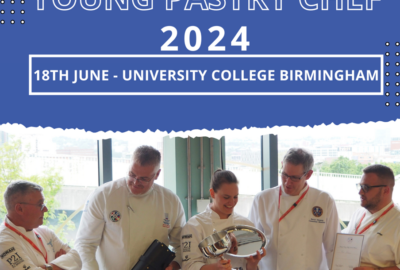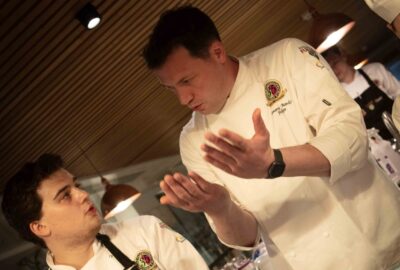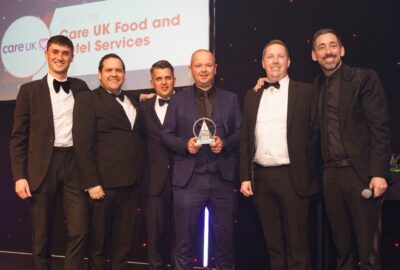Food tourists from overseas are demanding more local dishes when they visit the UK, a VisitBritain study reveals. Visitors are eating up the flavours and history of uniquely UK plates of food which are on offer in England, Wales, Scotland and Ireland. We asked some of the UK’s finest chefs to share their top tips for attracting food tourism.
Republic of Ireland – Chef Catherine Fulvio www.ballyknocken.com
How do Ireland’s local dishes impact on tourism? Here at Ballyknocken Farmhouse & Cookery School we have been welcoming tourists for just shy of 50 years. Over that period we can see a growth in the tourists’ knowledge of Irish food. These days’ visitors are looking for more experiences, such as learning how to cook using our local ingredients. Above all they want to see local and direct farm produce.
What is the world view of Irish food? The perception of Irish food has changed a lot. I have a cookery slot on NBC’s Today Show where I get to showcase Irish food and produce. On St Patrick’s Day every year the Irish Americans request a recipe for corned beef and cabbage and every year I have to break the bad news that is not an Irish dish! There are a lot of misconceptions about Irish food but thankfully Bord Bia and Tourism Ireland are doing a fantastic job in presenting and promoting what is real food.
If you had to recommend one dish to overseas visitors, what would it be? As a Wicklow lamb farmer of many generations I would have to say Wicklow lamb, it’s known locally as Honey Heather lamb. The herds enjoy the benefits of valleys of green pastures in the winter and the mountains where they spend the summer. But it is difficult to pick one dish to suit all – the French love lamb but the Americans not so much. The Americans haven’t had the good the fortune of experiencing quality lamb and therefore they don’t have a huge appreciation it seems.
Northern Ireland – Chef Danny Millar www.ballooinns.com
How do the locality of your dishes impact on tourism? Visitors are much more concerned with what they are eating these days and they tend to be well-travelled with experienced palates. The majority of our seafood, meat, potatoes all come from the immediate locality and that’s what tourists want to know. The three pubs I have are in the country, so we support the local farmers and they support us.
What is the world view of Northern Irish food? We have visitors from New Zealand and Australia. We put a pizza oven in last summer and a couple were visiting from Milan. They said that our courgette and artichoke pizza is as good as something they would get at home.
If you had to recommend one dish to overseas visitors, what would it be? Irish stews are popular all year round, made with fresh and local ingredients – with or without meat. You can tell the difference when we keep it seasonal and local. We also have a few great local cheeses to recommend such as Young Buck Blue, like aged Stilton.
England –Chef Michael Heathcote www.higherbuck.com
How do the locality of your dishes impact on tourism? I have noticed, at both lunch and dinner, guests making a special journey, and we certainly have more and more guests staying with us on mid-week mini breaks. This is simply a combination of our amazing natural larder, the skill of the producers and the wealth of talent we have cooking in the area.
What is the world view of English food? I honestly think, particularly in my area which is Lancashire/Ribble Valley, that we have always been held in high regard for our food offering. This reputation is certainly spreading thanks to an increased interest in food and marketing campaigns.
If you had to recommend one dish to overseas visitors, what would it be? We are always a fan of recommending our locally-bred beef which we cook on a specially designed Esse grill. We feature game as much as possible during the season. We are lucky to be offered game from the many local shoots, and we offer venison most of the year, as this is proving extremely popular.
Scotland – Chef David Littlewood www.kildrummyinn.co.uk/dining & Chef Chris Rowley www.ballintaggart.com
How do Scotland’s local dishes impact on tourism? Chris: Positively. Food is firmly at the centre of our guest experience and tourists are ready to fall for the magic of Scotland and our food which allows them to literally taste the place. Guests love to discover a hidden foodie gem, taste new flavours and ingredients and learn a little about our amazing artisans and producers. Before they leave, they always ask us for recommendations of other places to eat or foodie gifts to take home. David: Scotland’s reputation as a global destination for food tourism is ever-growing. The popular misconception that Scottish cuisine consists of little more than deep-fried Mars Bars and chip suppers, has come to an end. We have noticed a surge in recent years in the number of guests who take and active interest in where their food comes from – is it local? How is it prepared? How mature is the meat? Where is the fish caught and landed?
What is the world view of Scottish food? David: At Tor Na Coille we have recently taken part in the production of a television series by an international 3 Michelin star restaurant (we cannot say which due to confidentiality agreements), tracing the changes in Scottish culinary culture. Food is getting lighter, due to a number of factors. People are more aware of healthy eating, chefs are more aware of how to develop flavours within dishes to highlight the quality of our natural larder, and international superstar chefs are seeking out Scottish produce for their menus and proudly promoting where the product comes from! Chris: Most frustratingly some guests still come with low expectations of our food. We work passionately to showcase some of Scotland’s finest ingredients and ensure that they all leave having experienced some of our world-class larder.
If you had to recommend one dish to overseas visitors, what would that be? Chris: I’d love for every visitor, of any nationality to taste Scottish venison, a wonderful wild product. Our current menu features blue roe deer, confit egg yolk, sprouts slaw and charred baby leeks. It sounds bold but it really is a dish worth tasting! David: In our restaurant, we tend to be very seasonal when it comes to devising and developing dishes for our menus. If you asked me the same question in each month of the year I would almost certainly give you a different answer!
Wales – Chef James Sommerin www.jamessommerin restaurant.co.uk
How does the locality of your dishes impact on tourism? We ensure high quality of ingredients and cook with passion. Within a 30-mile radius, we get all our beef and lamb. I also enjoy cooking vegetarian dishes, and try to showcase really good vegetarian food. I really enjoy cooking veg dishes that are amazing to taste. It’s about being honest to the vegetable and treating it with respect, we don’t plunge any veg into water here. It is usually cooked sous vide, usually with a fat content of some kind – vegan food with almond oil.
What is the world view of Welsh food? We had a group of American tourists recently and they stopped off here for a 14 course tasting menu on the chefs’ table. They were absolutely mesmerised by what we are doing here, the standard of food and what we were producing with a small team. They hadn’t seen anything like it outside of London and were amazed we use 90% local produce.
If you had to recommend one dish to overseas visitors – what would it be? We serve Welsh lamb, which is sourced within a mile of here, cooked two ways; leg and loin and served with a little tarragon mayonnaise, broad beans, pink turnip and cumin. Basically we roll with the seasons. We have some signature dishes, one which I produced on the Great British Menu in 2009, and it’s liquid pea ravioli with parmesan, crispy sage and ham. Good comfort food.


